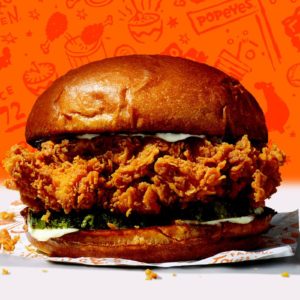3 PR and Marketing Lessons From the #chickensandwichwars

On August 12, Popeyes, the Louisiana fried chicken franchise, released the Popeyes Chicken Sandwich and the public went mad. If you haven’t already waited in an hour-long line to try the sandwich-gone-viral—you’re out of luck. Just two weeks since its debut, Popeyes announced that the sandwich is temporarily sold-out due to the “extraordinary demand.”
Fast-food restaurants release new menu items all the time; What makes the Popeyes Chicken Sandwich different? Marketing and PR strategies are definitely at play. Here are three PR and Marketing takeaways from the Chicken Sandwich Wars:
- Social is King (obviously)
Although an overt observation, the chicken sandwich launch would not have been as monumental without social media buzz. Because of mentions on platforms such as Instagram Stories and Twitter, consumers flocked to the nearest Popeyes to try the sandwich themselves.
Apex Marketing Group estimated that Popeyes reaped $65 million in equivalent media value— the price a company would have to pay to purchase the attention it received for free as a result of the Chicken Sandwich Wars. Apex considers television, radio, online and print news reports, as well as social media mentions.
2. Don’t be afraid to engage competitors
Popeyes capitalized on the social chatter by adding to and amplifying the conversation— not hesitating to participate in friendly banter with its competitors like Chick Fil A and Wendy’s. The Popeyes social management team also crafted witty, humorous retorts to competitor’s tweets such as:
Sounds like someone just ate one of our biscuits. Cause y’all looking thirsty. https://t.co/89eqI5vk2z
— Popeyes Chicken (@PopeyesChicken) August 20, 2019
Popeyes would reply and retweet its customers that compared the different fast food chicken sandwiches in taste tests via Twitter with the hashtag #chickensandwichwars. Even Emeril Lagasse, celebrity chef and restaurateur, weighed in on the chicken rivalry:
It’s #Friday and it’s time to try out this @PopeyesChicken sandwich. #ChickenSandwichWars pic.twitter.com/AJAElQNp8A
— Emeril Lagasse (@Emeril) August 23, 2019
The hype of the #chickensandwichwars resulted in increased followers and sales not only for Popeyes but Chick Fil A and Wendy’s as well. In this case, the rising tide lifted all ships … or one could say the rising chicken lifted all sandwiches.
3. Decrease supply to increase demand
The craze, fueled by social media, caused demand to exceed supply, even though Popeyes projected inventory would last until the end of September. On August 27th, the company tweeted that the chicken sandwich was sold out, and it was met with over 20,000 retweets:
Y’all. We love that you love The Sandwich. Unfortunately we’re sold out (for now). pic.twitter.com/Askp7aH5Rr
— Popeyes Chicken (@PopeyesChicken) August 27, 2019
Conspirators may say the shortage has less to do with inventory and more to do with marketing strategy. The marketing ploy gives Popeyes a reason to invite eager customers to download the Popeyes app for updates and notifications when the sandwich is back in stock. The app’s push notifications provide better access to its customers for future promotions and new menu rollouts. Plus, the buildup will have consumers watering at the mouth, excited to get the sandwich when it returns.
Social media and marketing strategy aside, the Popeyes Chicken Sandwich would not have been the triumph it was if the sandwich wasn’t actually pretty tasty.
@The_A_Prentice said it best with the tweet,
One day our children will ask us, where were you during the chicken sandwich wars of ‘19. https://t.co/U62Vr3030X
— Prentice Penny (@The_A_Prentice) August 20, 2019
